In the world of watches, chronographs grab the spotlight. Their popularity endows them with disproportionate influence within a brand’s range. Done right, they have what it takes to become, dare we say it, icons.
This Year’s SIHH saw the launch of the Calibre de Cartier chronograph. The introduction could almost have gone unnoticed, overshadowed by Cartier’s haute horlogerie offerings, but the chronograph has its own unique importance. In its more accessible permutations, it will serve as an initial stepping stone into the world of Cartier, and it will grace more wrists than its higher-priced siblings. It will be seen more often, by more people. It is powered by Cartier’s first automatic-winding, in-house chronograph movement, and the brand makes strong claims about the benefits of its twin-barrel design – claims that extend to other models further up the ladder that share this feature.
We’ll see how those claims hold up in the real world. The case and bracelet make a good start, Cartier manufactures them itself, and the execution stands with the best in this price range. The satin finish on the case is very fine and evenly applied. The outside edge of each lug exhibits a polished bevel that catches the light. This is a nice detail. The polished crown and chronograph pushers contrast with the brushed case. The crown bears Cartier’s trademark deep blue synthetic spinel crystal. (Because it has facelets, it is not a cabochon, which is defined as a smooth stone.) The seven-sided crown is stylish but slightly slippery, though the winding action is so smooth and easy you will not mind.
The elongated chronograph pushers have an organic, asymmetric shape that makes them easy to manipulate. The pushers are mounted on top of a substantial crown guard, so they limit access to the crown from the sides. The crown can be pulled out only from the bottom using a fingernail. When it is pulled out, the crown is solid, with no play.
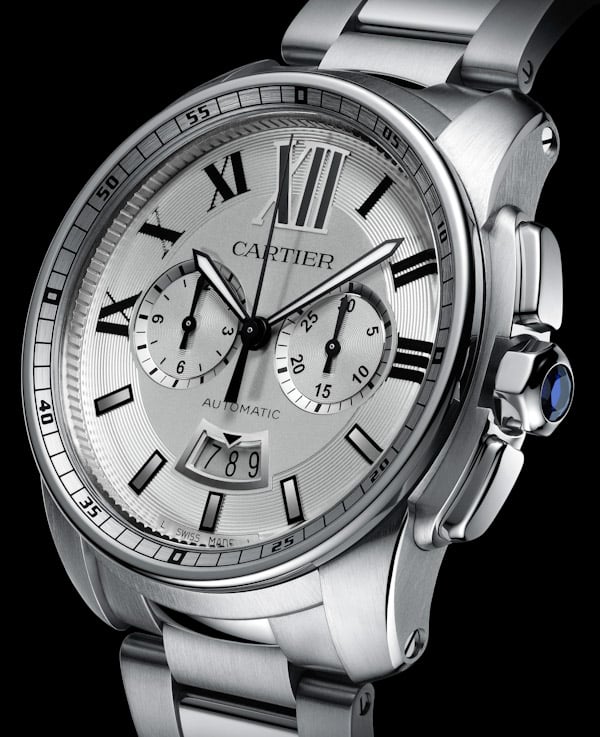
As is often the case with vertical-clutch chronographs, the start button required more pressure than the stop and reset functions. During our test, the start, stop and reset action was precise, and the vertical-clutch engaged the elapsed seconds hand as intended by its designer, with no jumps or shutter. The minutes counter neither crept nor jumped instantly, but moved from one market to the next during the last two seconds of each elapsing minute. The only chronograph-related fault to report is that the hour counter on our test watch did not reset precisely to zero, but stopped just short of dead top center. The elapsed seconds and minutes hands reset perfectly.
The thin bezel has an unusual shape. The outside edge and top lip are polished. From the outer edge, the bezel angles down toward the dial, and this angled surface is brushed and engraved with a railroad-style seconds track that is attractive, but does not provide the split-seconds indications one might expect on a chronograph.
The caseback, with sapphire display window, is attached to the case with eight screws. The engravings around the edge are well executed, and they tell us that the case is water resistant to 100 meters. The caseback shape works with the curved lugs to provide an excellent fit on the wrist.
Cartier’s press materials list this chronograph’s diameter as 42 mm, which is what you get measuring the case from 12 to 6 o’clock. In reality, the watch looks and wears larger. The thin bezel contributes to the “wears large” perception; however, the oversize pushers and crown guard contribute the most to the oversize effect. Include those elements inside the caliper’s jaws, and the watch’s diameter is about 46 mm.
The bracelet’s craftmanship matches the case. The milled links exhibit fine finishing on all surfaces. All edges are slightly rounded. Everything is put together with screws. The highly polished center links vary in size, creating a subtle effect on the steel bracelet, but a much more pronounced statement on the steel and gold version. Some enthusiasts may not like the fact that the lugs are somewhat thicker than the bracelet’s attachment piece, so the lugs protrude slightly above the bracelet where it meets the case.
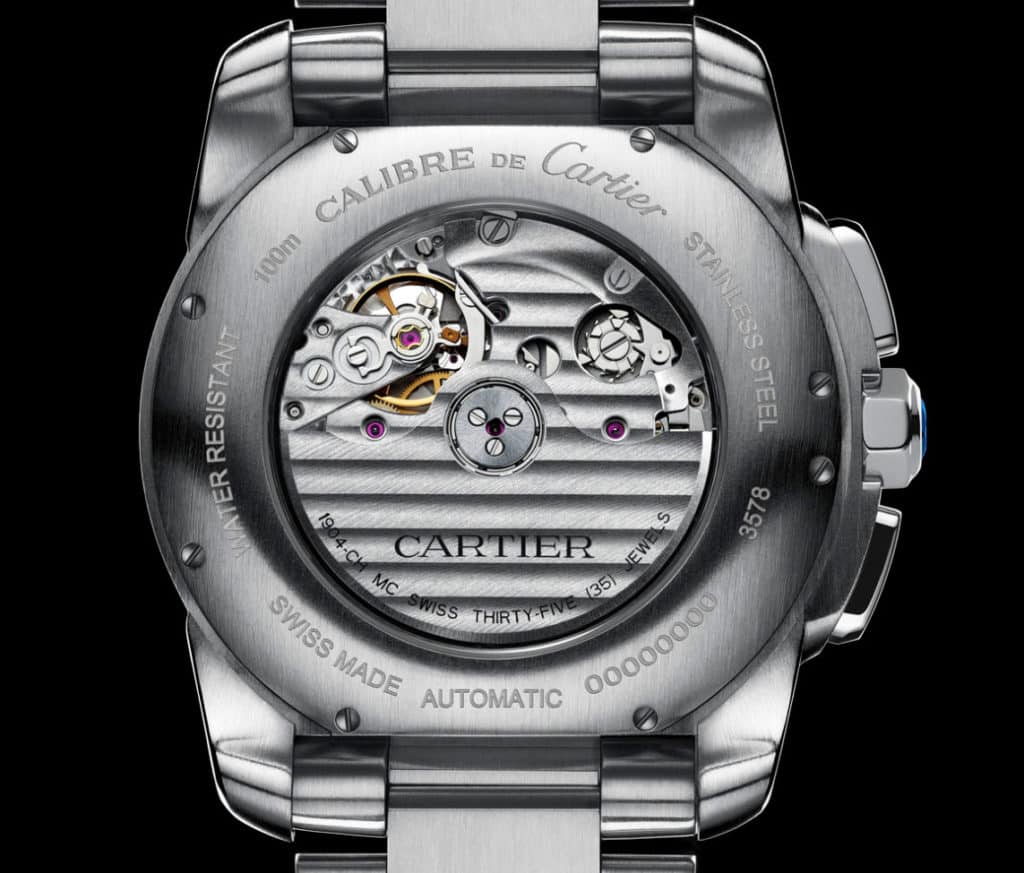
The bi-fold clasp is also solid and well made, with a curve that hugs the wrist. The twin push-buttons that open the clasp are easy to access and do not push against the wrist. Half-links improve the sizing range, though the bracelet lacks a micro-adjustment feature. The bracelet feels solid and well made, and its weight is appropriate for the case, so the watch stays put on the wrist. The overall fit and comfort are very good.
The Silver Opaline dial is protected by a domed sapphire crystal that has no anti-reflective coating. Like the dial’s perimeter, the chronograph subdials are snailed and slightly sunken, and they are surrounded by beveled, polished silver rings. The subdial surrounds mimic the bezel’s slender, sloping surface, and they catch and reflect light, which adds life to the dial, but the reflections can make it difficult to read the elapsed time.
The bi-compax layout features a 30-minute counter at 3 o’clock and a 12-hour counter at 9 o’clock. The continuous seconds, located at 6 o’clock on the Calibre de Cartier model launched in 2010, are not carried over to the chronograph’s display, though Cartier advised us that the small seconds mechanism remains present in the chronograph’s movement. It has been said that the primary function of the seconds hand is to indicate whether the watch is running. We would have appreciated that instant cue during our test. As discussed below, those who desire visual signs of life will be happy to learn that the movement is designed to allow the chronograph seconds to run continuously without affecting timekeeping accuracy. We’ll see how well the design performs in the timekeeping tests.
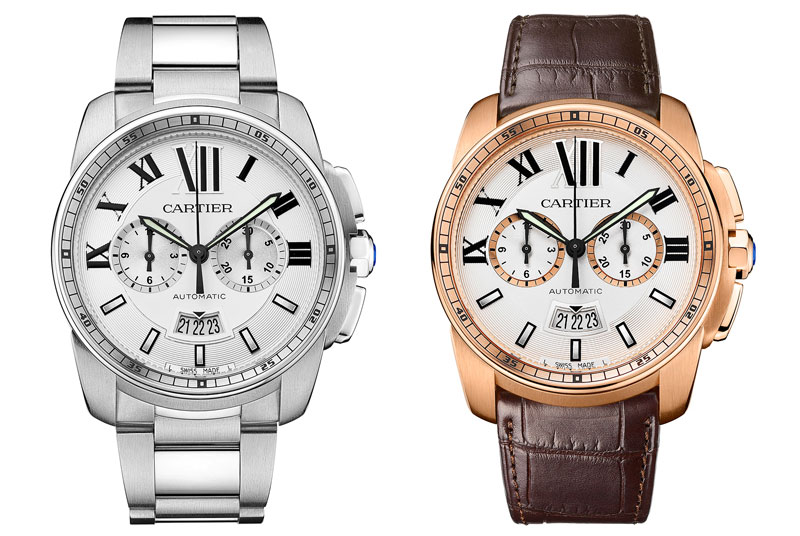
The semi-circular date is located at 6 o’clock, rather than the more traditional 3 o’clock position where it is found on the Calibre de Cartier automatic. The silver-bordered aperture displays three numerals. A small black triangle in the center calls out the date. The date is of the instant-change variety, though on our test watch, the disk began a barely discernible advance at about 11:15 p.m., then jumped forward to the next date at midnight. The date also has what might be called a slow-motion, one-way quick-set feature. Some systems advance the date several digits with each turn of the crown.
The Cartier system required a long turn of the crown (or two short turns) to advance the date by a single day, and the date can be advanced forward, but not back. The dial layout is nicely symmetrical, as long as you don’t consider the hour markers. Bold, oversize Roman numerals mark the hours from 9 to 3 around the top of the dial, and broad stick markers from 4 to 8 on the lower portion of the dial. The oversize “XII” marker is especially extravagant, while the “X” hour marker incorporates Cartier’s micro-writing anti-counterfeit feature, consisting of the name “Cartier” spelled out in tiny letters in one of the crosspieces of the “X”.
The sword-shaped hour and minutes hands are black oxidized steel with a generous application of luminous material. The dial and hands offer good contrast and legibility during daylight hours, though both hands fall well short of their associated tracks. The hour hand in particular is quite short, though its diminutive size aids in reading the date around 6 o’clock, when a longer hand could interfere. The dial has no luminous markers, so reading the time at night is not an exercise in precision. In our test, from a full charge, the hands glowed very brightly during the first hour, though the brightness declined considerably after two hours.

The glow from the hands remained faint but legible after six hours, and after seven hours, the time could no longer be read. The chronograph cannot be read in the dark. Beneath the dial lies the in-house Caliber 1904-CH MC movement, and it’s not what you might think. Many a brand with an in-house automatic movement in its arsenal would simply add a module to create its in-house chronograph. Cartier did not take that easy route. The automatic Caliber 1904-PS that debuted in 2010 was designed from the beginning to become an integrated chronograph. Cartier left space for the chronograph hand’s axes to pass through, including in the center of the movement.
The Caliber 1904-CH chronograph mechanism is mounted on the barrel bridge (which is to say on the bridge side of the movement, not the dial side). The original movement was also developed to allow integration of the central vertical-clutch in connection with the central seconds wheel. The chronograph mechanism adds 1.71 mm to the base movement’s 4-mm thickness, while the jewel count rises from 27 to 35, and the parts count from 227 to 269.
The 1904-CH chronograph caliber carries over the base movement’s key features, one of which is twin, series-coupled mainspring barrels. The twin barrels were not designed to provide an extended power reserve – the Calibre chronograph’s autonomy is a traditional 48 hours. Rather, the twin barrels are designed to provide chronometric stability as the mainsprings wind down. To use an automotive analogy, Cartier is seeking a flat torque curve. The goal was to create a movement that keeps time equally well at both full and reduced states of wind. Cartier also claims that movement durability is improved because the twin barrels turn at a faster rate while delivering less force.
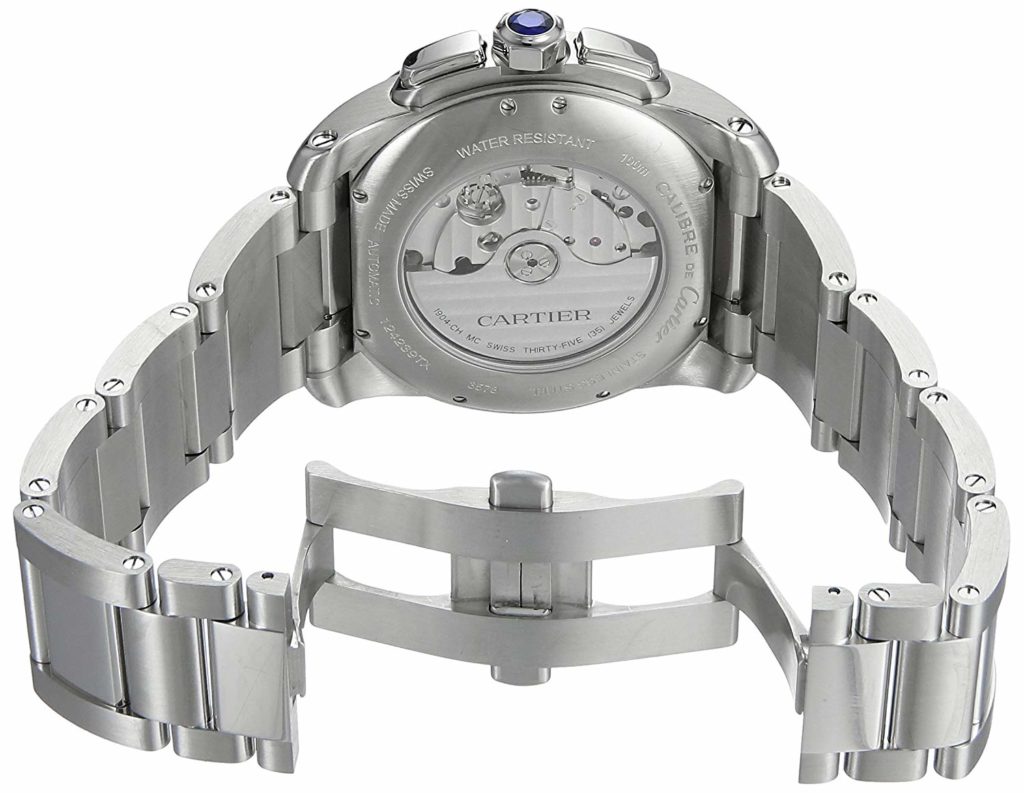
The twin mainsprings are wound by a bi-directional rotor mounted on ceramic ball bearings that improve longevity and eliminate the need for lubrication. In place of conventional reversers, Cartier uses a V-shaped pawl that increases winding speed. Caliber 1904-CH incorporates three important chronograph features: a column wheel, a vertical clutch, and so-called “linear soft resetting.” The column wheel controls the chronograph’s start, stop and reset functions. Column-wheel fans appreciate the system’s difficulty and expense to manufacture, its smooth feel, and its aesthetics. Cartier created an aperture in the automatic winding bridge that allows the owner to view the switching mechanism in action.
Cartier also uses a vertical clutch to connect the wheel train with the chronograph. Cartier chose this construction because it delivers more consistent power to the escapement. The vertical clutch uses fewer wheels and so saves power, reducing the “chronograph drag” that can significantly reduce the balance wheel’s amplitude when the chronograph is engaged, and so affect timekeeping. Cartier says the vertical clutch allows owners to leave the chronograph seconds running continuously without affecting the power reserve or the timekeeping accuracy. The vertical clutch also eliminates the stutter or jump often seen in lateral-coupled (meshing wheel) mechanisms when the chronograph is engaged.
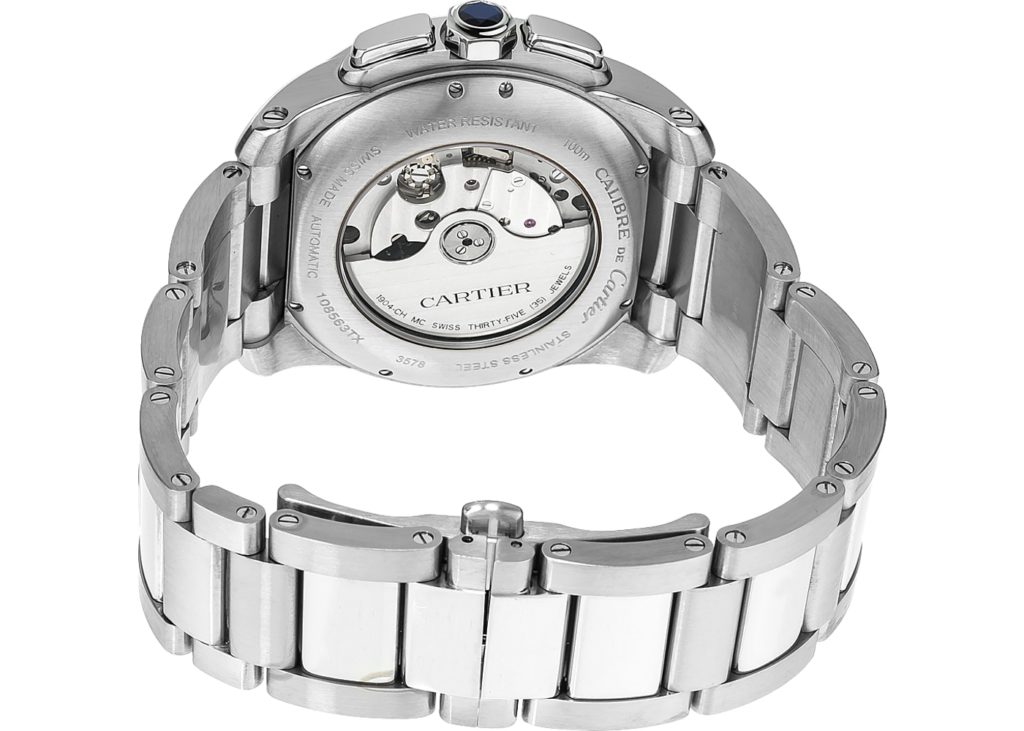
Cartier calls its final special feature “linear soft resetting”. In this construction, a single sliding bar is crafted with three fingers that act as hammers to reset the elapsed-time displays. “Soft resetting” refers to the fact that the hammers are slightly flexible. Cartier says this improves the durability of the chronograph hands’ axes by softening the blows the hammers inflict with each use. Over time, these impacts can affect how the axes, and the wheels, rotate in their jewels. Cartier claims its design minimizes these effects.
Viewd through the caseback, the movement presents a sea of waves, with both the winding rotor and its oversize bridge decorated with cotes de Geneve. The bottom plate, which is not visible, is circular-grained. The rotor is engraved with the Cartier name and with text indicating the caliber designation, its Swiss origin, and the jewel count. The movement’s architecture is designed to be robust and reliable, not to maximize the owner’s viewing pleasure. The automatic winding bridge covers most of the movement, though, as noted, Cartier thoughtfully created an aperture to reveal the column wheel.
The screws are highly polished. The anglage and countersinks do not exhibit the high polish found on calibers in Cartier’s higher-priced Fine Watchmaking Collection. The movement uses a Glucydur balance wheel, Nivarox hairspring and Incabloc shock protection. The Etachron fine adjustment system takes the shape of the Cartier “C”.
Caliber 1904-CH is not chronometer rated, and Cartier makes no claims about timekeeping accuracy, other than to say that the movement meets its internal standards, which it does not disclose.
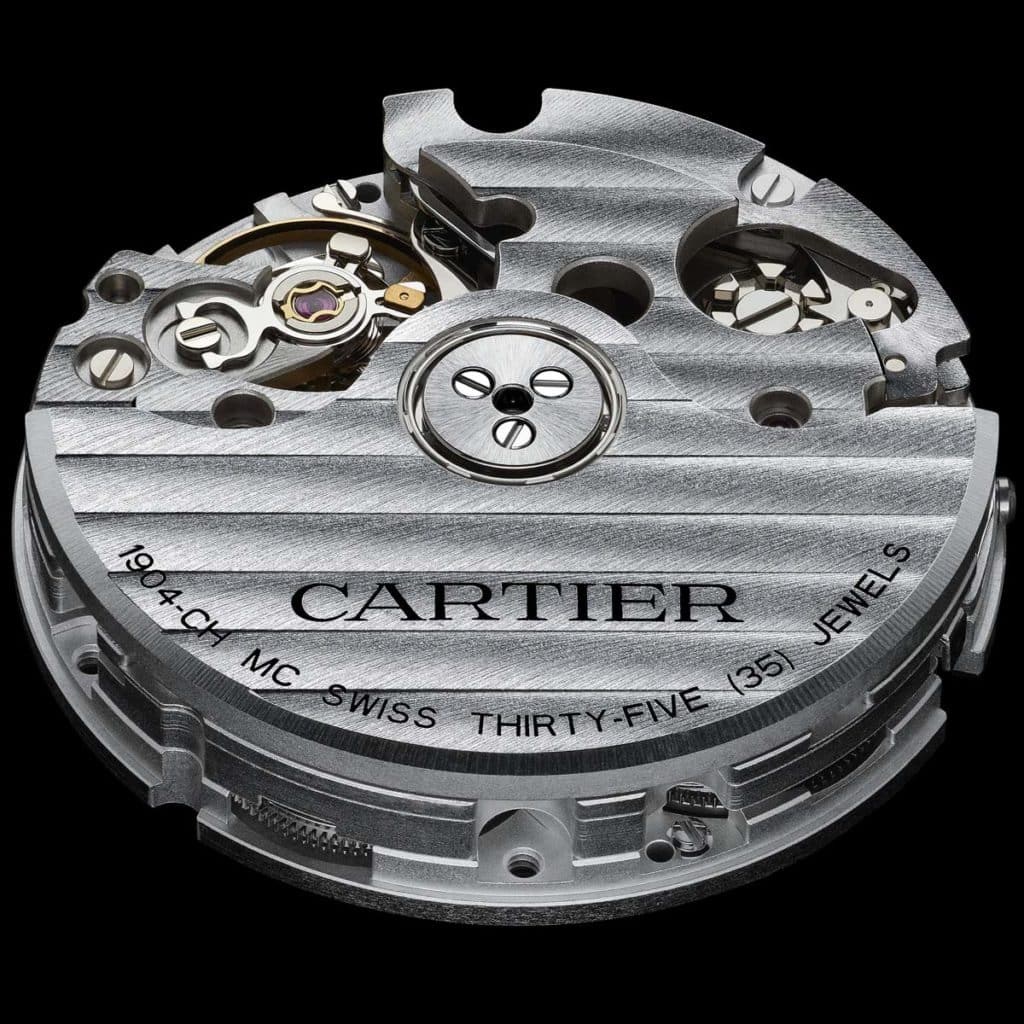
Out timing tests, on both the Witschi machine and on the wrist, largely confirmed Cartier’s claims regarding the benefits of its twin-barrel system. With the chronograph of at full wind, the average daily rate in all positions was +8.3 seconds. Engaging the chronograph improved the timekeeping, reducing the average daily rate in all positions by 0.8 seconds to +7.5 seconds. On the wrist, with the chronograph running continuously, the Calibre de Cartier chronograph performed even better, gaining five seconds over 24 hours.
To test Cartier’s claim about improved performance at lower states of wind, we also tested the watch on the Witschi machine after it had run for 24 hours, depleting 50 percent of its power reserve. The Calibre chronograph’s average daily rate slowed slightly, making it a better timekeeper, and engaging the chronograph had zero effect on the average daily rate, which was +7.7 seconds with the chronograph both off and on.
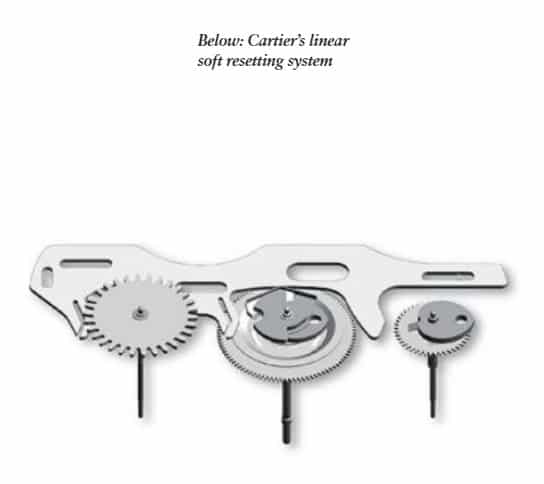
Other brands offer integrated, manufacture chronographs for less money, but they do not carry the Cartier brand cachet and most do not offer its double-barreled advantages. If you’re looking for a technical tool watch that lets you read split-second elapsed times with ease, the Calibre de Cartier chronograph will not suit your needs. If you’re interested in an elegant statement from a design leader and haute horlogerie powerhouse, the Calibre de Cartier chronograph may be for you.






